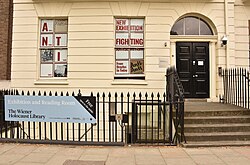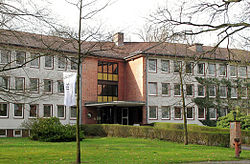
The Wiener Holocaust Library is one of the world’s foremost Holocaust memorial institutions and research libraries. It is also the oldest such library, having evolved immediately after the war out of the Jewish Central Information Office, established by Alfred Wiener, a German Jew, all the way back in 1933 when the Nazis first came to power in Germany. The material gathered by Wiener here was later used extensively by those charged with investigating and prosecuting the Nazis for perpetrating the Holocaust or Shoah, the mass-murder of approximately six million European Jews during the Second World War. Based out of Russell Square in the Bloomsbury district of north-central London, the library is a major genealogy and family history resource, with extensive material on Europe’s over ten million Jewish people at the commencement of the war and what happened to them in the years that followed.[1]
Research your ancestors on MyHeritage
The Holocaust in European historyThe Holocaust in European history

The Holocaust or Shoah was the most destructive and systematic attempted genocide in human history. Anti-Semitism became particularly pronounced across Europe in the second half of the nineteenth century and into the early twentieth. The causes of this rising tide of Anti-Jewish sentiment have been widely discussed, with everything from new theories of social and cultural evolution and the emergence of radical socialist movements like the communists being blamed for the phenomenon. More broadly, the rising tide of nationalist sentiment which was leading to the emergence of new nation states across the continent in the nineteenth and early twentieth centuries brought with it a tendency to ‘other’ different ethnic groups. In a similar vein, the modern era has seen numerous other genocides in Europe such as the Armenian and Bosnian genocides where there was a swell of Turkish and Serb nationalism. Whatever the causes, we do know that this rising tide of Anti-Semitism resulted in a growing number of pogroms against Jews in countries like the Russian Empire and in political scandals like the Dreyfus Affair in France.[2]
As bad as these early manifestations of Europe’s expanding Anti-Semitism were, they paled by comparison with what was unleashed by the Nazis in Germany and then occupied Europe between 1933 and 1945. Visceral hatred of the Jewish people was a foundational element of German National Socialism, with Nazi leaders like Adolf Hitler taking the species of Anti-Semitism that had already existed in Germany prior to the First World War and amplifying it by arguing that Germany’s defeat and humiliation in that conflict was part of a vast Jewish conspiracy to destroy Germany. Although many western nations would wish to deny it today, this virulent strain of Anti-Jewish thought had equivalents in many other countries. Henry Ford, for instance, one of the key architects of the automobile revolution in the early twentieth century, entered the publishing industry after the First World War with the express intent of disseminating around the United States his elaborate conspiracy theories about how the war had been orchestrated by the Jewish people to benefit financially from it.[3]
In Germany the country’s half a million or so Jewish people faced an increasing array of persecutory legislation under the Nuremburg Laws following the rise to power of Hitler and the Nazis early in 1933. In the run up to the 1936 Summer Olympics in Berlin the Anti-Semitism of the regime was toned down, but as the Nazis began the march to war with the annexation of Austria and the Sudetenland in 1938, things ratcheted up. The Knight of the Broken Glass (Kristallnacht) occurred on the 9th and 10th of November 1938, as thousands of Jewish businesses and synagogues were attacked and many Jews were arrested, with dozens killed.[4]
Once the Second World War began and Germany occupied Poland, the scale of the so-called ‘Jewish Question’ became every greater in the minds of the Nazis. There were over three million Jewish people living in Poland alone, while other regions like France, the Netherlands, Ukraine and Belarus that were occupied in the course of 1940 and 1941 also had large Jewish communities, meaning that by the end of 1941 there were nearly 10 million Jewish people living either under the rule of the Nazis or their allies across Europe.[5]

Up until then the Nazi high command had been considering various plans for solving the ‘Jewish Question’, one being a bizarre scheme to deport Europe’s people to the island of Madagascar off the coast of eastern Africa.[6] But with the war effort meeting with success on all fronts, more brutal policies were experimented with, eventually resulting in the mass murder of tens of thousands of Jews in Ukraine at places like Babi Yar on the 29th and 30th of September 1941. It was around this time that the Nazi Einsatzgruppen, squads of SS death commandos, began gassing people to death in specially designed trucks on the Eastern Front.[7]
The final step towards the ‘Final Solution’ was the decision to expand the gassing program and to locate it within six ‘death camps’ in the part of Poland governed by the General Government. These would be Auschwitz-Birkenau, Treblinka, Sobibor, Majdanek, Chelmno and Belzec. Following the Wannsee Conference, held in the suburbs of Berlin on the 20th of January 1942, where 15 senior Nazi ministers and officials worked out the details of it, the Final Solution commenced. Over the next three years, well over three million Jewish people were transported to the six camps and killed by the Nazi regime.[8]
Some camps and periods were particularly brutal. For instance, after the Nazis took direct control over Hungary in the spring of 1944 they commenced the Shoah in a country which had otherwise avoided it. Over 400,000 of the country’s 750,000 Jewish people were killed at Auschwitz-Birkenau in less than six months. When combined with the 1.5 to 2 million Jewish people killed by the Einsatzgruppen on the Eastern Front and the million or so other Jewish people who either starved to death, were worked to death or were summarily executed in parts of occupied Europe, the death toll from the Holocaust eventually reached around six million people, the largest genocide in human history.[9]
The Wiener Holocaust LibraryThe Wiener Holocaust Library
The Wiener Holocaust Library in London is the world’s oldest Holocaust museum. This is because it was actually established in 1933 before the Holocaust ever even occurred. In this original iteration it was termed the Jewish Central Information Office, was based out of Amsterdam and was ran by Alfred Wiener, a German Jew who fled Germany as soon as the Nazis came to power there early in 1933. The original remit of the Central Information Office was to act as a lobby group to petition the Dutch, French, British, US and other governments about the danger posed by the Nazi regime. In late 1938, following the Kristallnacht in Germany, and in expectation of a European war to come, Wiener relocated to London and continued his lobbying efforts there. On the 1st of September 1939, coincidentally the day the Second World War began, he opened the library in London. With the end of the war in 1945, the Jewish Central Information Office became a research resource for those investigating the war crimes perpetrated by the Nazis. Over time it became known as the Wiener Holocaust Library. It is based out of Russell Square in Bloomsbury in London today.[10]
Genealogical research at the Wiener Holocaust LibraryGenealogical research at the Wiener Holocaust Library

The Wiener Holocaust Library houses one of the most important Jewish research libraries and Holocaust libraries in the world today, with over 70,000 books, tens of thousands of photographs and original documents from the period of the Second World War and the Nazi regime’s actions in Germany before it, over a million press-cuttings and a large audio-visual collection.[11] There is also a refugee collection, with a wide range of material pertaining to the stories of European Jews who managed to flee from the Nazi-occupied territories between 1939 and 1945. These have been mapped on an interactive database in recent years.[12] Perhaps most significantly, the Wiener Holocaust Library is the sole point of access within the UK to the Arolsen Archive (previously the International Tracing Service) based out of Bad Arolsen in Germany, a repository of over 30 million pages of material pertaining to the Holocaust and the experience of 17.5 million people thereof, both Jewish and non-Jewish. This makes the Wiener Holocaust Library one of the most important Jewish genealogical and family history resources in the world.[13]
See alsoSee also
Explore more about the Wiener Holocaust LibraryExplore more about the Wiener Holocaust Library
- Jewish Holocaust Memorials and Jewish Residents of Germany 1939-1945 records collection on MyHeritage
- Lithuanian-Jewish Records from LitvakSIG, 1795-1940 records collection on MyHeritage
- World Jewish Congress Records of Holocaust Survivors from JewishGen records collection on MyHeritage
- Germany, Dachau Concentration Camp Records from JewishGen records collection on MyHeritage
- Documenting Families or Communities Lost in the Holocaust by Bullets at Legacy Family Tree Webinars
References
- ↑ https://wienerholocaustlibrary.org/
- ↑ William I. Brustein and Ryan D. King, ‘Anti-Semitism in Europe before the Holocaust’, in International Political Science Review, Vol. 25, No. 1 (2004), pp. 35–53.
- ↑ https://www.pbs.org/wgbh/americanexperience/features/henryford-antisemitism/
- ↑ https://www.history.com/topics/holocaust/kristallnacht
- ↑ https://encyclopedia.ushmm.org/content/en/article/jewish-population-of-europe-in-1933-population-data-by-country
- ↑ https://www.jewishvirtuallibrary.org/the-madagascar-plan-2#google_vignette
- ↑ https://www.theholocaustexplained.org/how-and-why/how/the-einsatzgruppen/
- ↑ https://www.yadvashem.org/holocaust/about/final-solution/death-camps.html
- ↑ https://encyclopedia.ushmm.org/content/en/article/introduction-to-the-holocaust
- ↑ https://wienerholocaustlibrary.org/who-we-are/history/
- ↑ https://wienerholocaustlibrary.org/what-we-have/
- ↑ https://www.refugeemap.org/
- ↑ https://wienerholocaustlibrary.org/what-we-do/research/its/

